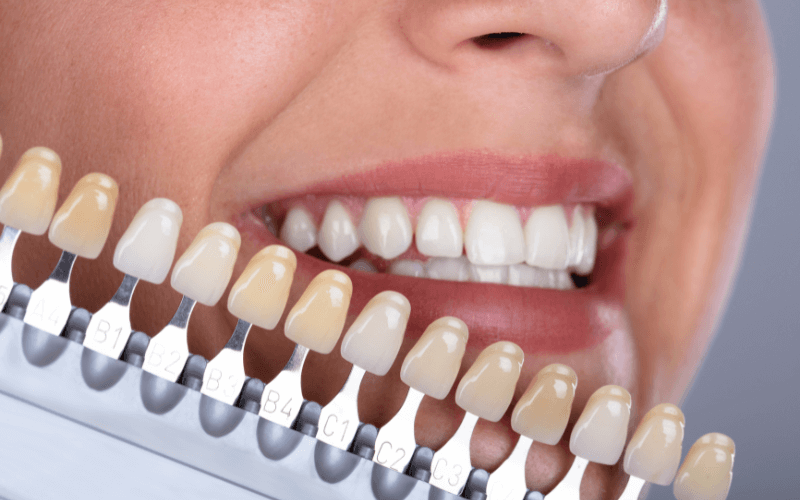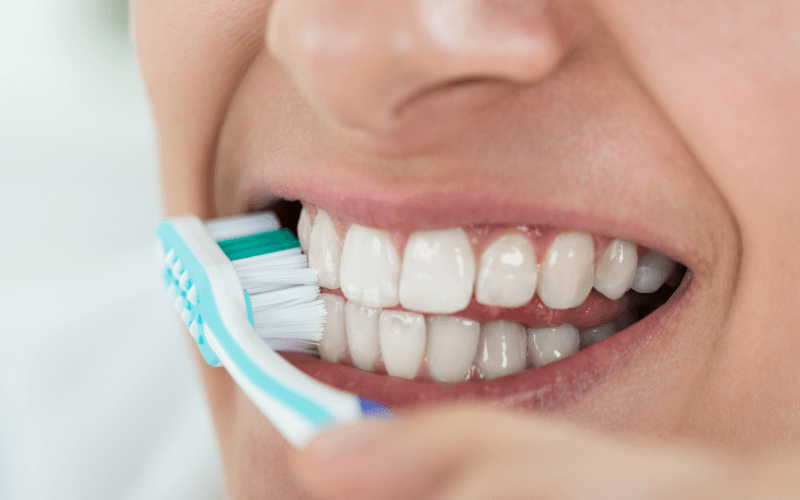Teeth whitening is a popular cosmetic dental procedure, but it’s often surrounded by myths that can be misleading and confusing. In this blog, we aim to separate truth from fiction, providing clarity on what teeth whitening really involves. From concerns about enamel damage to the effectiveness of different whitening methods, we’ll explore and debunk common misconceptions. By understanding these myths and facts, you can make informed decisions about teeth whitening and achieve the best results for your smile.
Myth 1: Teeth Whitening Damages Enamel
A common myth is that teeth whitening procedures damage tooth enamel, leading to increased sensitivity and vulnerability. This concern primarily stems from misconceptions about the chemicals used in the whitening process. In reality, when performed correctly, either by a professional or using safe, at-home kits, teeth whitening is not harmful to the enamel.
The active ingredients in whitening products, typically hydrogen peroxide or carbamide peroxide, work by breaking down complex stains on the tooth surface, making them less concentrated and the teeth appear whiter. This chemical reaction does not affect the structure or health of the enamel. In professional settings, dentists take additional steps to protect the gums and surrounding mouth areas from these chemicals, further ensuring safety.
It’s also worth noting that teeth whitening products have undergone extensive testing and research, and their regulated use is considered safe for the enamel. However, overuse or misuse of over-the-counter products can lead to enamel damage. Hence, it’s crucial to follow product instructions carefully or to opt for professional treatment.
Fact 1: Results Vary Among Individuals
The effectiveness of teeth whitening treatments varies significantly from person to person, and understanding this can set realistic expectations. The variation in results is due to several factors:
Natural Tooth Colour
Everyone’s teeth have a natural base colour, ranging from more yellow to grayish, which will influence the final outcome of whitening. Some individuals naturally have a whiter tooth enamel, allowing for more dramatic results.
Type of Staining
The cause of tooth discolouration plays a key role in how well teeth respond to whitening. Extrinsic stains, typically caused by foods, drinks, or smoking, are generally easier to lighten compared to intrinsic stains, which are internal and can result from certain medications, trauma, or fluorosis.
Age Factor
As we age, the enamel wears down, and the naturally yellower dentin underneath becomes more visible. This natural aging process can affect the whitening process, as older teeth may not lighten as effectively as younger teeth.
Dental History
Previous dental work, especially on front teeth, can influence whitening. Materials used in dental restorations (like fillings and crowns) do not respond to whitening agents. Therefore, individuals with extensive dental work may experience uneven whitening.
Recognising that teeth whitening isn’t a one-size-fits-all solution is essential. A professional dental consultation can provide an accurate assessment of what you can expect from the treatment, tailored to your unique dental profile. This understanding helps in managing expectations and achieving the most satisfactory whitening outcomes.
Myth 2: Over-the-Counter Products are as Effective as Professional Treatments
It’s a common belief that over-the-counter (OTC) teeth whitening products offer the same results as professional dental treatments. While OTC products can be effective, there are key differences:
Concentration of Whitening Agents
Professional treatments typically use higher concentrations of whitening agents. This means they can often achieve more noticeable and faster results compared to OTC products.
Customisation and Supervision
Dental professionals tailor treatments to individual needs, considering factors like tooth sensitivity and the specific type of staining. This personalised approach not only tends to be more effective but also safer. In contrast, OTC products are one-size-fits-all and lack professional supervision.
Longevity of Results
Professional treatments often offer longer-lasting results. This is partly due to the stronger agents used and the thorough application process.
Safety and Comfort
Dentists ensure that the gums and other soft tissues in the mouth are protected during professional whitening procedures. With OTC products, there’s a greater risk of gum irritation or misuse, which can lead to sensitivity or damage.
While OTC products can be a good option for minor staining and budget-conscious users, for more significant or stubborn discolouration, professional treatment is usually more effective and reliable. Understanding this distinction can help you choose the most suitable option for your teeth whitening needs.
Fact 2: Not Everyone is a Suitable Candidate for Teeth Whitening
Not everyone is an ideal candidate for teeth whitening, and it’s important to understand who should avoid it or approach it cautiously:
People with Sensitive Teeth
Those with sensitive teeth or gums may experience increased discomfort during and after whitening treatments.
Individuals with Dental Restorations
Since dental restorations like fillings, crowns, or veneers do not respond to whitening treatments, people with numerous restorations, especially in visible areas, might see uneven whitening results.
Young Patients
Teeth whitening is typically not recommended for children and teenagers since their teeth are still developing. Additionally, younger individuals are more likely to experience sensitivity.
Pregnant or Nursing Women
It is generally advised that pregnant or nursing women postpone cosmetic dental treatments, including teeth whitening, as a precaution.
People with Intrinsic Stains
Intrinsic stains, which are within the tooth, such as those caused by certain medications, trauma, or fluorosis, are not effectively treated with standard whitening procedures.
A dental professional can assess your oral health and determine if teeth whitening is appropriate for you, considering these and other individual factors. Consulting with a dentist ensures that you approach teeth whitening safely and with realistic expectations.
Myth 3: Teeth Whitening is a One-Time Procedure
Many people think that once their teeth are whitened, they’ll stay bright and white forever. However, teeth whitening is not a one-time procedure. Here’s why:
Natural Discolouration
Over time, teeth naturally discolour due to factors like aging, food, and drink.
Lifestyle Factors
Habits such as smoking, and consuming staining foods and drinks, contribute to the teeth gradually losing their whiteness.
Oral Hygiene
Poor oral hygiene can accelerate the re-staining process. Regular brushing, flossing, and dental check-ups are essential to maintain results.
Maintenance Treatments
To keep your teeth looking their brightest, maintenance treatments or touch-ups are often necessary, especially if you continue to consume staining substances.
Understanding that teeth whitening requires ongoing care and occasional re-treatment can help set realistic expectations and encourage good oral hygiene and lifestyle habits to prolong the results.
Fact 3: Certain Foods and Drinks Can Stain Whitened Teeth
After teeth whitening, it’s important to be mindful of your diet as certain foods and drinks are known to cause staining:
Common Staining Culprits
Beverages like coffee, tea, red wine, and dark-coloured sodas are notorious for staining teeth. Foods like berries, tomato sauce, and curry can also cause discolouration.
Mechanism of Staining
These foods and drinks contain chromogens, intensely pigmented molecules which cling to dental enamel, causing staining. Additionally, acidic foods and beverages can erode enamel, making it easier for stains to set in.
Preventative Measures
To minimise staining, it’s advisable to consume these foods and drinks in moderation. Drinking water or rinsing your mouth after consuming them can help reduce their staining effect. Using a straw for beverages can also minimise their contact with your teeth.
Making small adjustments can have a significant effect on maintaining your bright smile.
Related reading: Understanding Tooth Discolouration: Causes And Prevention
Myth 4: Whitening Toothpaste Alone Can Whiten Teeth Dramatically
Whitening toothpaste is often believed to significantly whiten teeth on its own, but this expectation may lead to disappointment:
Composition and Function
While whitening toothpastes can remove surface stains due to their abrasive ingredients, they typically lack the bleaching agents like hydrogen peroxide found in professional whitening treatments. Therefore, their ability to lighten the actual colour of the teeth is limited.
Best for Surface Stains
These toothpastes are more effective at combating surface stains from foods and drinks, maintaining the natural colour of the teeth rather than whitening them several shades lighter.
Role in Maintenance
Whitening toothpaste is better suited for maintaining the results of a professional whitening treatment rather than providing dramatic whitening results on its own.
Realistic Expectations
It’s important to have realistic expectations when using whitening toothpaste. For significant changes in tooth colour, professional treatments are usually necessary.
Understanding the capabilities and limitations of whitening toothpaste helps in choosing the right products for your teeth whitening goals and maintaining your smile post-treatment.
Fact 4: Whitening Treatments Do Not Affect the Internal Structure of Teeth
An important fact about teeth whitening is that it primarily affects the external appearance of teeth without altering their internal structure:
Surface-Level Action
The bleaching agents used in teeth whitening treatments work on the surface of the teeth, targeting stains on the enamel without penetrating deeper into the tooth.
Preservation of Tooth Integrity
Unlike some other dental procedures, teeth whitening does not remove, alter, or weaken the structure of the teeth. This means the fundamental integrity and strength of your teeth are maintained.
No Effect on Dental Restorations
Whitening treatments do not change the colour or structural integrity of dental restorations such as fillings, crowns, or bridges.
Understanding that teeth whitening is a cosmetic process that brightens the smile without compromising the natural makeup of your teeth can be reassuring, especially for those concerned about the health and longevity of their teeth.
While whitening treatments can effectively brighten smiles, they are not a one-size-fits-all solution and require proper care and maintenance. Knowing what to expect, which products to use, and how lifestyle and dietary choices impact the longevity of whitening results can make a significant difference. It’s important to consult with dental professionals, like those at Dental Aspects, who can provide personalised advice and treatment options tailored to your specific needs. This informed approach ensures that you not only achieve a brighter smile but also maintain it effectively for the long term.
Discover a Brighter Smile: Teeth Whitening Services at Dental Aspects
At Dental Aspects, we specialise in transforming smiles with our Cosmetic Dentistry services like our teeth whitening solutions. We offer both professional in-chair whitening using Philips Zoom WhiteSpeed, renowned for its rapid and effective results, and convenient take-home kits like Philips Zoom NiteWhite and DayWhite for those preferring to whiten their teeth at their own pace. Our treatments are tailored to your individual needs, ensuring the best possible results while prioritising your oral health and comfort. We invite you to schedule a consultation with us at our dentists’ Browns Plains clinic to discuss the most suitable option for your oral health. Just call us at (07) 3800 8899 to book your appointment.
Keep Reading: What Is A Root Canal? And Do I Need One?



